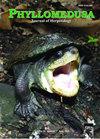Behavioral responses of tadpoles of Clinotarsus curtipes (Anura: Ranidae) to odor cues of dragonfly larvae
IF 0.6
4区 生物学
Q4 ZOOLOGY
引用次数: 0
Abstract
In aquatic environments, many prey animals, including anuran larvae, predominantly use chemical cues to assess predation risk. In such systems, a variety of chemical cues (e.g., kairomones, alarm, dietary) affect the behavioral responses of the prey tadpoles. Many anuran tadpoles are able to discriminate different chemical cues and exhibit differential antipredator behavioral responses according to the perceived risk. The behavioral responses of tadpoles of Clinotarsus curtipes to predatory larvae of the dragonfly Pantala flavescens were studied in the laboratory. The predator’s kairomones (water conditioned by a starved predator) or its diet-derived metabolites released in excreta of a predator after consumption of conspecific (C. curtipes) or heterogeneric (Indosylvirana temporalis) prey tadpoles were used to simulate predation threat. The tadpoles of C. curtipes had no behavioral response to predator kairomones. However, the tadpoles showed antipredator behavioral responses i.e., reduced swimming movements and overall time spent swimming, and had a higher burst speed in response to water-borne cues released from the excreta of predators fed both conspecific and heterogeneric prey. The antipredator behavioral responses of tadpoles were most intense in response to cues of predators fed on conspecific prey. The findings of the present study show that tadpoles of C. curtipes are capable of assessing levels of predation threat and modulating the intensity of their defense behavior in accordance with the perceived threat.蛙蛙科蝌蚪对蜻蜓幼虫气味信号的行为反应
在水生环境中,包括无尾幼虫在内的许多猎物主要使用化学线索来评估捕食风险。在这样的系统中,各种化学线索(如信息素、警报、饮食)会影响被捕食蝌蚪的行为反应。许多无核蝌蚪能够辨别不同的化学线索,并根据感知的风险表现出不同的反捕食者行为反应。在实验室中研究了弯趾蛙蝌蚪对黄蜻蜓捕食性幼虫的行为反应。捕食者的kairomones(饥饿捕食者调节的水)或其在捕食者排泄物中释放的饮食衍生代谢产物,在食用同种(C.curtipes)或异源(Indosylvirana temporalis)猎物蝌蚪后被用来模拟捕食威胁。curtipes的蝌蚪对捕食者kairomones没有行为反应。然而,蝌蚪表现出抗捕食者的行为反应,即减少了游泳动作和游泳的总时间,并且对捕食同种和异源猎物的捕食者排泄物释放的水传播线索有更高的爆发速度。蝌蚪对捕食同种猎物的捕食者的线索的反应最为强烈。本研究的结果表明,C.curtipes的蝌蚪能够评估捕食威胁的水平,并根据感知到的威胁调节其防御行为的强度。
本文章由计算机程序翻译,如有差异,请以英文原文为准。
求助全文
约1分钟内获得全文
求助全文
来源期刊

Phyllomedusa
ZOOLOGY-
CiteScore
1.00
自引率
25.00%
发文量
0
审稿时长
24 weeks
期刊介绍:
PHYLLOMEDUSA publishes original research articles, short communications and review papers concerning the whole field of Herpetology. PHYLLOMEDUSA also maintains sections for Book Reviews. Manuscripts will be considered on condition that they have not been published elsewhere or are not under consideration for publication, in whole or in part, in another journal or book. Publication inPHYLLOMEDUSA, including color pictures, is free of charge. All manuscripts are subject to peer review. This process averages 90 days. Authors receive pdf proofs before publication and 30 reprints free of charge. Full-text pdf versions of all articles are available for free download in this homepage.
 求助内容:
求助内容: 应助结果提醒方式:
应助结果提醒方式:


